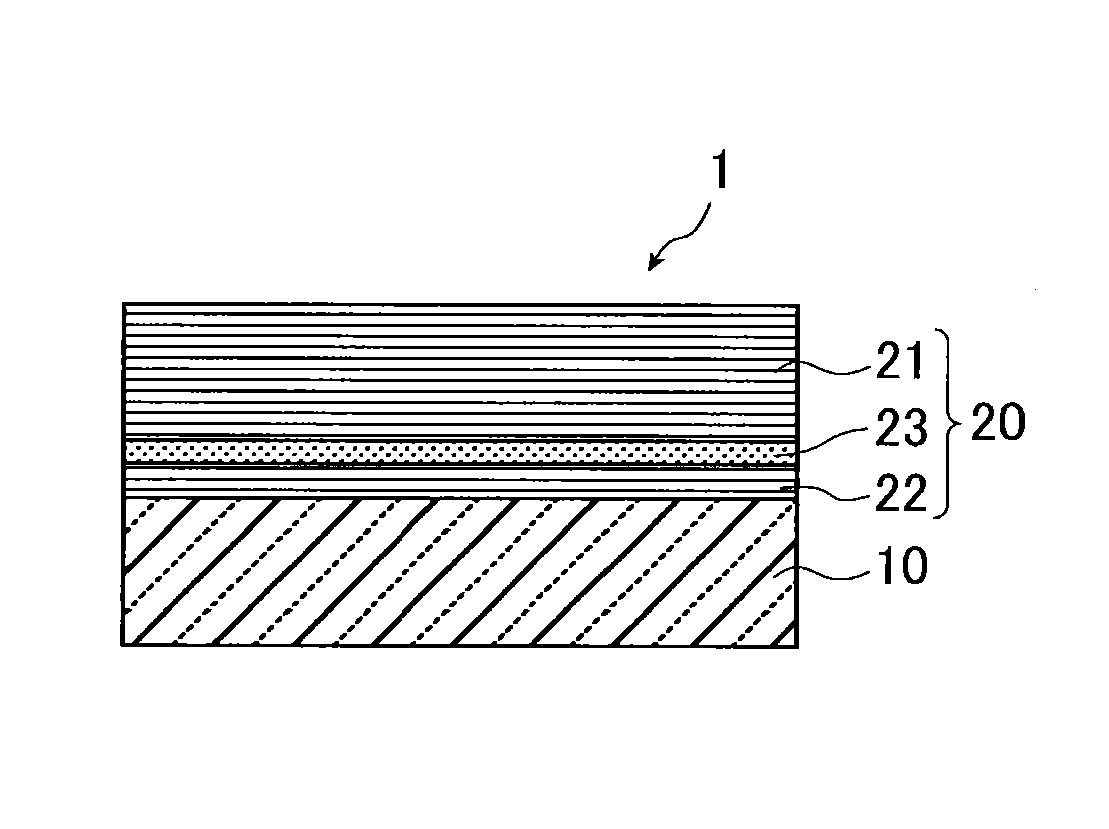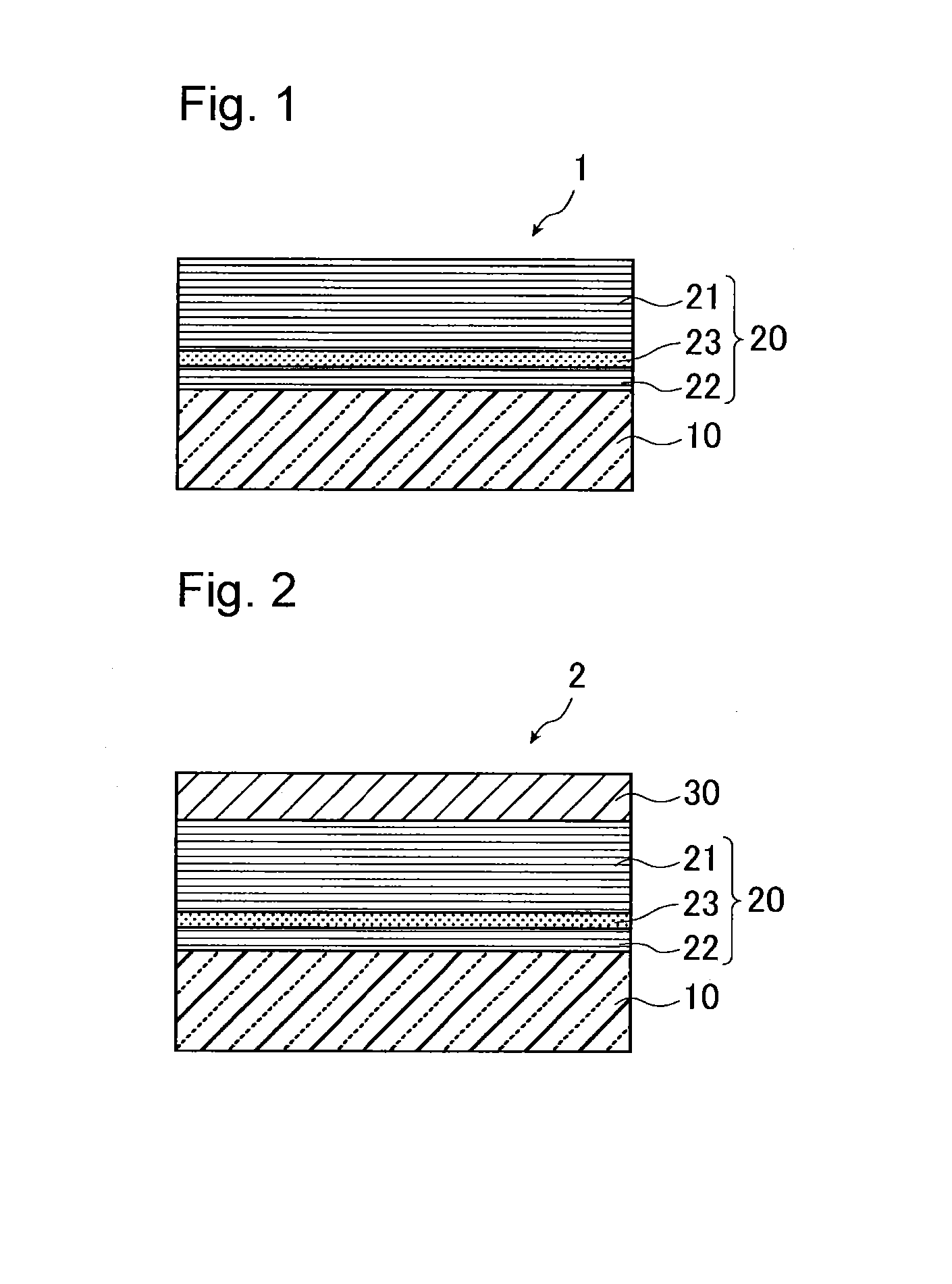Reflective mask blank for EUV lithography, and reflective layer-coated substrate for EUV lithography
- Summary
- Abstract
- Description
- Claims
- Application Information
AI Technical Summary
Benefits of technology
Problems solved by technology
Method used
Image
Examples
example 1
[0158]In this Example, a reflective layer-coated substrate 1 for EUVL as shown in FIG. 1 was prepared.
[0159]As a substrate 10 for film formation, a SiO2—TiO2 type glass substrate (size: 6 inches (152.4 mm) square, thickness: 6.3 mm) was used. The thermal expansion coefficient of this glass substrate was 0.05×107 / ° C., the Young's modulus was 67 GPa, the Poisson ratio was 0.17, and the specific rigidity was 3.07×107 m2 / s2. This glass substrate was polished to form a smooth surface having a surface roughness rms of at most 0.15 nm and a planarity of at most 100 nm on the main surface side on which a reflective layer was to be formed.
[0160]On the rear surface side of the substrate 10, a Cr film having a thickness of 100 nm was formed by a magnetron sputtering method to provide an electrically conductive coating (not shown in the drawings) having a sheet resistance of 100Ω / □.
[0161]By using the formed Cr film, the substrate 10 (size: 6 inches (152.4 mm) square, thickness: 6.3 mm) was fix...
example 2
[0193]This Example was carried out in the same manner as in Example 1 except that the second multilayer reflective film 22, the adjustment layer 23 and the first multilayer reflective film 21 were as follows.
Second Multilayer Reflective Film 22
[0194]Mo layer: 3 nm
[0195]Si layer: 4 nm
[0196]Second cycle length d2: 7 nm (0.9d1≦d2≦1.1d1 is satisfied.)
[0197]Mo layer / d2: 0.43 (from 0.25 to 0.55 is satisfied.)
[0198]Number of sets: 10 (from 3 to 31 sets is satisfied.)
[0199]Total thickness: 70 nm
Adjustment Layer 23
[0200]Mo layer: 2.4 nm
[0201]Si layer: 1.6 nm
[0202]Third cycle length d3: 4 nm (d3≦0.8d1 is satisfied.)
[0203]Mo layer / d3: 0.6 (from 0.3 to 0.7 is satisfied.)
[0204]Number of sets: 8
[0205]Total thickness L: 32 nm (as i=4, (0.3+4)d1≦L≦(0.7+4)d1 is satisfied.)
First Multilayer Reflective Film 21
[0206]Mo layer: 3 nm
[0207]Si layer: 4 nm
[0208]First cycle length d1: 7 nm (6.8 nm≦d1≦7.2 nm is satisfied.)
[0209]Mo layer / d1: 0.43 (from 0.25 to 0.55 is satisfied.)
[0210]Number of sets: 30 (from 20...
example 3
[0216]This Example was carried out in the same manner as in Example 1 except that the second multilayer reflective film 22, the adjustment layer 23 and the first multilayer reflective film 21 were as follows.
Second Multilayer Reflective Film 22
[0217]Mo layer: 3 nm
[0218]Si layer: 4 nm
[0219]Second cycle length d2: 7 nm (0.9d1≦d2≦1.1d1 is satisfied.)
[0220]Mo layer / d2: 0.43 (from 0.25 to 0.55 is satisfied.)
[0221]Number of sets: 10 (from 3 to 31 sets is satisfied.)
[0222]Total thickness: 70 nm
Adjustment Layer 23
[0223]Mo layer: 1.6 nm
[0224]Si layer: 2.4 nm
[0225]Third cycle length d3: 4 nm (d3≦0.8d1 is satisfied.)
[0226]Mo layer / d3: 0.4 (from 0.3 to 0.7 is satisfied.)
[0227]Number of sets: 1
[0228]Total thickness L: 4 nm (as i=0, (0.3+0)d1≦L≦(0.7+0)d1 is satisfied.)
[0229]First multilayer reflective film 21
[0230]Mo layer: 3 nm
[0231]Si layer: 4 nm
[0232]First cycle length d1: 7 nm (6.8 nm≦d1≦7.2 nm is satisfied.)
[0233]Mo layer / d1: 0.43 (from 0.25 to 0.55 is satisfied.)
[0234]Number of sets: 30 (fr...
PUM
 Login to View More
Login to View More Abstract
Description
Claims
Application Information
 Login to View More
Login to View More - Generate Ideas
- Intellectual Property
- Life Sciences
- Materials
- Tech Scout
- Unparalleled Data Quality
- Higher Quality Content
- 60% Fewer Hallucinations
Browse by: Latest US Patents, China's latest patents, Technical Efficacy Thesaurus, Application Domain, Technology Topic, Popular Technical Reports.
© 2025 PatSnap. All rights reserved.Legal|Privacy policy|Modern Slavery Act Transparency Statement|Sitemap|About US| Contact US: help@patsnap.com


